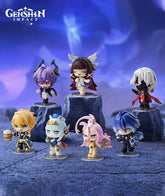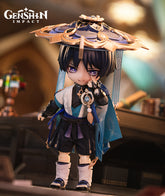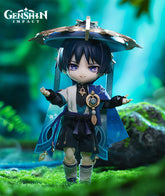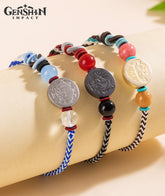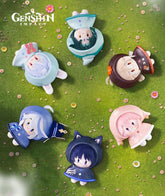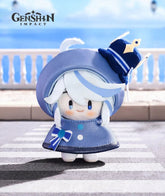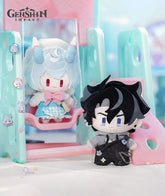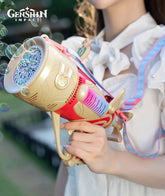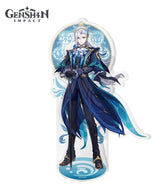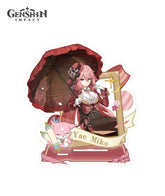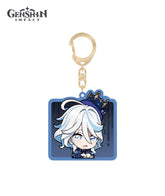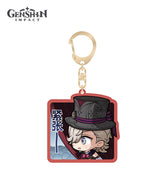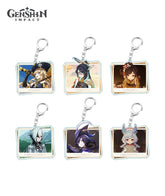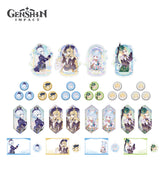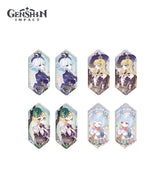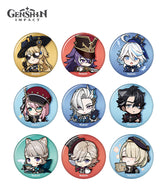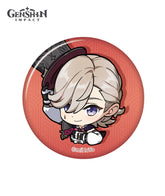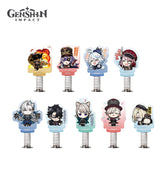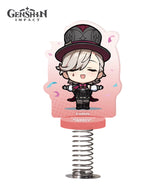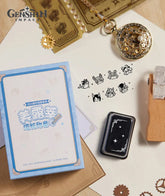Genshin Sigewinne Analysis: Is Sigewinne From Mondstadt?
Travelers must be familiar with Sigewinne by now, as we've frequently discussed her intricate details and extensively covered the origins of Melusines. But do you know the design inspirations behind Sigewinne? What hidden nuances define her aesthetics? Today, join us in a deep dive into the lore of Melusines!
1. The original literary inspiration for Genshin Impact's Sigewinne
The name "Sigewinne" originates from a medieval German epic. In the tale, a hero, starving during his journey, encounters a shaggy, bear-like wild man. Upon learning the hero's identity, the wild man declares, "I know you're a great hero. I'll feed and heal you-but at a cost: you must marry me." The horrified hero draws his sword to fight.

Calmly, the wild man bathes in a spring, shedding his fur to reveal Sigewinne-a cursed ancient Queen of Troy. This mirrors Sigewinne's in-game use of potions to assume human form. Some variants name her "Sigeminne." Smitten by her beauty, the hero (Wolfdietrich, from Wolf + Dietrich) agrees. Dietrich, an Old German name meaning "ruler of the people," evokes "wolf-like sovereign"-strikingly aligning with Wriothesley's characterization.
Astute Travelers may question, why does Fontaine, steeped in French-inspired Romantique culture, adopt a Mondstadt-esque Germanic prototype? While Dietrich heroes typically reference Theodoric the Great (500 CE Ostrogothic Kingdom), Wolfdietrich's story uniquely parallels Clovis I, the first Frankish king. His "Wolf" epithet stems from childhood years spent in a wolf den-a consequence of his parents (a prince and princess) concealing their illegitimate child in the wilderness.

The princess, confined to a tower by her father (who forbade male visitors), was wooed by the prince disguised as a woman. After legitimizing his rule as Byzantine emperor, he publicly wed her. Later, slanderers cast doubt on Wolfdietrich's lineage, sparking a civil war. His three-year siege ended with a desperate breakout for reinforcements-where he met Sigewinne. Historians note Wolfdietrich's narrative derives not from Gothic lore but from Frankish history (proto-French), justifying Sigewinne's presence in Fontaine's Francophone milieu.
In-game, when no quests are active, players can find a Melusine named Ottnit in Meropide's infirmary-a direct reference to Ortnit from the epic, whom Wolfdietrich sought for reinforcements. Their relationships vary across versions: In some, Sigewinne is kidnapped by giants, and Ortnit aids Wolfdietrich in rescuing her;

In others, Sigewinne dies of illness, and Wolfdietrich discovers Ortnit slain by a dragon. Ortnit's widow vows to marry whoever avenges her husband-a near-identical twin of Sigewinne. Wolfdietrich slays the dragon and weds her.

The tale concludes with Wolfdietrich crushing the traitors with reinforcements. He fathers a son, and his great-grandson Dietrich von Bern becomes the central figure in Germanic heroic epics, even crossing into Nibelungenlied to duel Hagen (Siegfried's killer)-cementing his role as the linchpin of the "Germanic Heroic Alliance."

2. The related "Tales of the Melusines"
Returning to Sigewinne herself: Though her initial depiction in the epic was brutish, the presence of scales in her literary description classifies her among water spirits. The German term Nix/Nixe is functionally equivalent to mermaids. In the Nibelungen cycle, the three maidens guarding the Rhinegold are Nixen, while analogous beings in French lore are Melusines and in Greek myths, Sirens. Key distinctions exist: Nixens act as divine bureaucrats; Sirens murder sailors as wild monsters; Melusines obsessively marry humans, magically fulfilling their spouses' desires-provided their bathing rituals remain unobserved, lest they revert to serpentine forms.

Historically, many French noble houses claimed Melusine descent, notably the Lusignans. During the Third Crusade, they ruled Cyprus, Jerusalem, Antioch, and Tripoli. Their alliance with Richard the Lionheart (Reinhardt) paved their entry into English royal politics. The English branch became Earls of Pembroke and founded Cambridge's Pembroke College.
According to legend, Raymond of Lusignan encountered a Melusine in a forest and proposed marriage. She agreed but forbade Saturday intrusions (her serpent-bathing day). She bore him ten children and conjured France's grandest castle. Yet Raymond's brothers spied on her bath, revealing her draconic form. Heartbroken, she transformed into a dragon and fled. Notably, the Lusignan-English lineage became Henry III's stepfathers, intertwining Melusine blood with the Plantagenets. This may explain Sigewinne's placement in Meropide (Fontaine's French-inspired prison): While Melusines were mere nobles in France, their English descendants became royalty.
3. The Enigma of Melusine Physique Design in Genshin Impact
Next, let's discuss the physique of Melusines in Genshin Impact. Whether it's the Germanic Nix, French Melusines, or Greek Sirens, these entities are typically depicted as adult women or adolescents. Yet in-game Melusines adopt a distinctly childlike form-what's the reasoning behind this?
Nix are freshwater spirits, Melusines have serpentine or piscine lower bodies, and Sirens are saltwater spirits with avian or fish traits. These distinctions categorize them into three separate mythological sets, all under the broader umbrella of "nymphs." In biology, "nymph" refers to an immature insect stage (distinct from larvae). Insects undergo either incomplete metamorphosis (egg → nymph → adult) or complete metamorphosis (egg → larva → pupa → adult). Nymphs lack fully developed wings and reproductive organs, which may partially explain the Melusines' juvenile design.

Another possible influence is Goethe's 1807 short story The New Melusine. Here, the protagonist's idealized wife is a Lilliputian princess carrying a tiny box (paralleling Sigewinne's medical kit)-a portal to her miniature kingdom. Their relationship ultimately fractures due to irreconcilable differences, reimagining the Melusine myth through themes of love, sacrifice, and existential boundaries. This "miniaturized perfection" motif could inform the game's design choices.

Another possible influence is Goethe's 1807 short story The New Melusine. Here, the protagonist's idealized wife is a Lilliputian princess carrying a tiny box (paralleling Sigewinne's medical kit)-a portal to her miniature kingdom. Their relationship ultimately fractures due to irreconcilable differences, reimagining the Melusine myth through themes of love, sacrifice, and existential boundaries. This "miniaturized perfection" motif could inform the game's design choices.
Speaking of Romanticism, the most widely circulated musical piece is Auld Lang Syne. In art, Romantics favored untamed landscapes and apocalyptic skies, pursuing emotional saturation beyond Neoclassical restraint. Yet with academies still dominated by Neoclassicism, few master painters emerged. A notable exception is Liberty Leading the People.

Romanticism's pivotal influence was fostering nationalism-the belief that "those sharing a language form an indivisible whole." Folktales, seen as "untainted" literary vessels, were deemed capable of preserving ethnic identity for millennia. This spurred the Grimm brothers to collect Germanic tales.
Hans Christian Andersen, though struggling with novels/plays, became Denmark's literary treasure through fairy tales. Post-Napoleonic defeats by Britain, Sweden, and Prussia, Denmark urgently needed cultural cohesion. The 1814 compulsory education reform (modeled after Germany) laid the groundwork for Andersen's popularity.
Notably, while the Grimms claimed authenticity, several tales (e.g., Little Red Riding Hood, Cinderella, Sleeping Beauty) were adapted from 17th-century French author Charles Perrault-a member of the Académie Française. Both Grimm and Andersen tales feature water spirits/mermaids, paralleling Sigewinne's "witch's transformative potion"-a clear nod to The Little Mermaid. As fairy tale figures, cuteness became essential. Intriguingly, French lacks "mermaid," translating directly to petite sirène ("little siren").
4. The Enigma of Sigewinne's Job Choice in Genshin Impact
Finally, let's discuss Sigewinne's profession! Why did miHoYo design her as a medical worker? During our earlier analysis of Neuvillette, we traced his efforts to integrate Melusines into human society to historical parallels like Henry IV's advocacy for Protestant equality-an inference that now holds increased credibility.

The Melusines in-game exhibit traits mirroring three pillars of Europe's modern transformation: their fascination with mechanical parts reflects the Industrial Revolution; their abstract aesthetic sense aligns with artistic movements like Romanticism; their "anomalous vision" (capable of perceiving microscopic details) symbolizes the rise of modern medicine through microscopy and anatomy. These seismic shifts are inextricably linked to the Protestant Reformation post-1517.
Unlike traditional Catholicism (which prioritized monastic asceticism over secular labor), Protestantism sanctified worldly work, championing diligence, frugality, and reinvestment of profits-ethos that catalyzed capitalism's cultural foundations: work discipline, rational efficiency, and delayed gratification. Such principles, when applied across industries, propelled societal progress.
In medical history, 1518 saw the founding of England's Royal College of Physicians, which decades later introduced the iconic "Victorian military surgical kit"-mirroring Sigewinne's lore about "Melusine-specific integrated portable medical devices." In 1543, Brussels physician Andreas Vesalius published De Humani Corporis Fabrica, correcting ancient errors (e.g., "men have fewer ribs than women because God created Eve from Adam's rib") and pioneering modern anatomy.
The 1590 Dutch invention of microscopes by the Janssen father to son revolutionized medicine. English physician William Harvey's 1628 De Motu Cordis established blood circulation theory. Robert Hooke's 1665 Micrographia coined the word "cell," while Antonie van Leeuwenhoek's 1676 300x microscope revealed the word "microorganisms." These milestones birthed scientific medicine, later refined by 19th-century anesthesia/bacteriology and 20th-century penicillin/aseptic techniques-transitioning from traditional empiricism to evidence-based practice.

In Genshin, Wriothesley embodies Industrial Revolution aesthetics; abstract artistry manifests in daily quests. Thus, Sigewinne naturally inherits the "dawn of modern medicine" as her core design motif.
5. Oath of Sigewinne in Genshin Impact
Finally, let us return to antiquity. Legend tells that Hippocrates' daughter, transformed into a dragon by the goddess Diana, could only regain human form through a knight's kiss. Yet all who sought her fled at the sight of her monstrous visage. Enraged, she slew each coward-the earliest known Melusine narrative.
Hippocrates, revered as the "Father of Medicine" for pioneering clinical observation, medical documentation, and prognostic analysis, authored the Hippocratic Oath. Its tenets-confidentiality, non-discrimination, non-maleficence, and self-awareness of limitations-remain foundational to medical ethics. Though revised over millennia (e.g., the 1948 Geneva Declaration and 1964 Lasagna versions), its core endures.

Below is Sigewinne's adaptation:
My teacher's golden rule was: "A doctor's duty is to treat whatever ailments they can." Doctors aren't gods, I know that - even the best doctors will come up against incurable diseases in their time. But that's okay. We Melusines have very long lives, so as long as I never stop studying medicine, the range of illnesses I can cure can only keep increasing, and the amount of suffering can only keep decreasing. I'll always follow my teacher's example, doing everything in my power to save the people I can reach... As long as it will help, and as long as I'm not harming anyone in the process, I'm willing to use any means necessary to treat my patients, whatever the risk to myself.
Thus concludes our comprehensive analysis of Sigewinne! Has this journey deepened your understanding of this unparalleled Melusine character? Beyond her endearing appearance, she embodies humanity's ascending staircase of progress. Stay tuned for more character deep dives and Genshin Impact merchandise!










